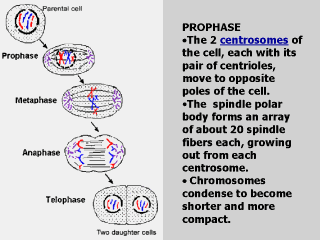| front |1 |2 |3 |4 |5 |6 |7 |8 |9 |10 |11 |12 |13 |14 |15 |16 |17 |18 |19 |20 |21 |22 |23 |24 |25 |26 |27 |28 |29 |30 |31 |review |
 |
PROMETAPHASE The nuclear envelope breaks down. The kinetochore resolves at the centromere of each chromatid. Spindle fibers attach to the kinetochores and to the arms of the chromosomes. For each dyad, one of the kinetochores is anchored to one pole, and the sister chromatid to the opposite pole. METAPHASE The dyads have reached equilibrium midway between the poles on the famous metaphase plate. The chromosomes are at their most compact. ANAPHASE Sister kinetochores separate, dragging attached chromatids (chromosomes) behind them. Separation depends on the breakdown of the cohesins that have been holding them together. It works like this. Cohesin breakdown is caused by the protease separase (also known as separin). Separase is kept inactive until late metaphase by the inhibiter chaperone called securin. Anaphase begins when the anaphase promoting complex (APC) destroys securin (by tagging it for deposit in a proteasome) thus ending its inhibition of separase and allowing separase breaks down the cohesins. TELOPHASE A nuclear envelope reforms around each cluster of chromosomes. These return to their more extended diffuse form. |